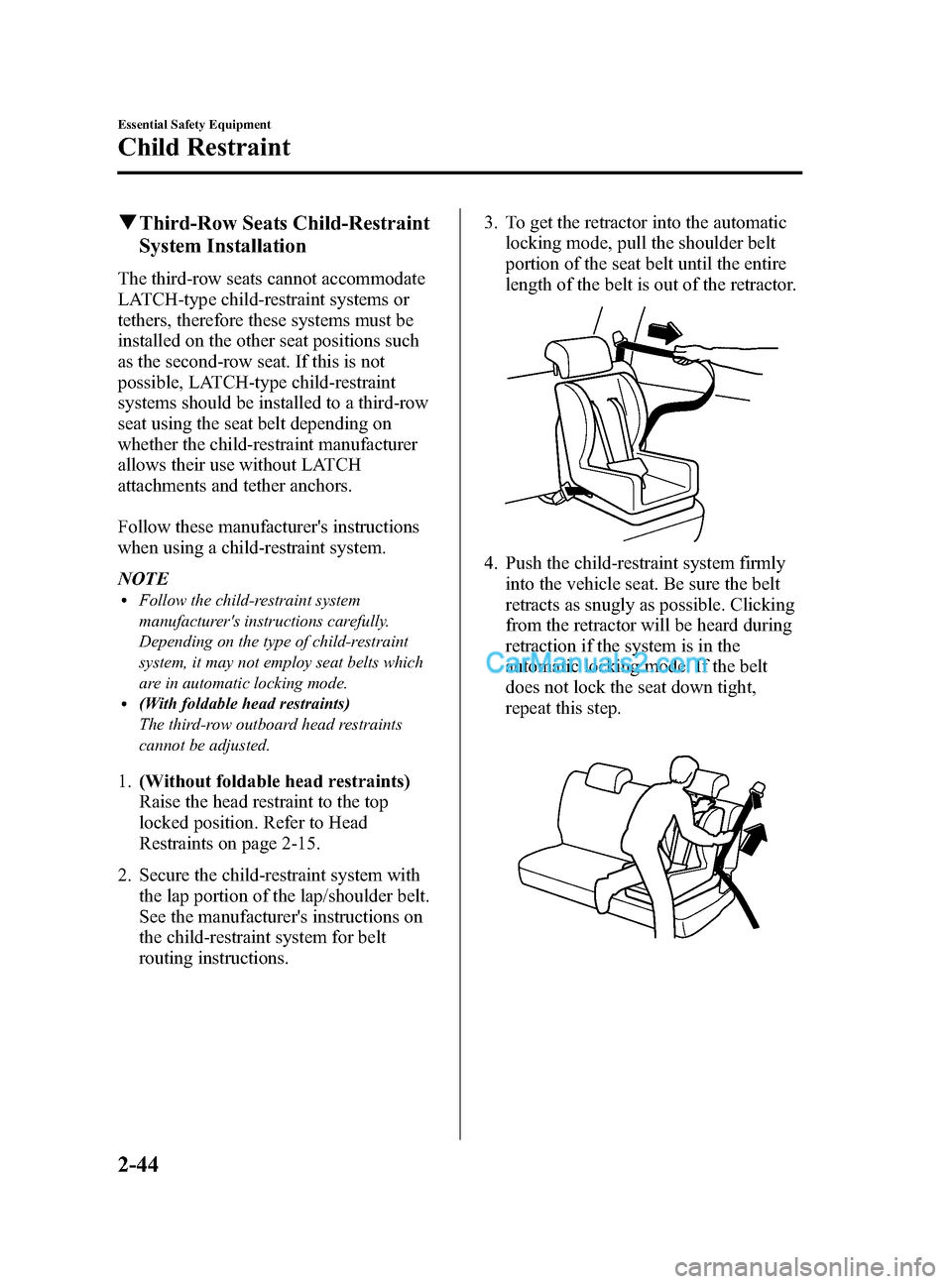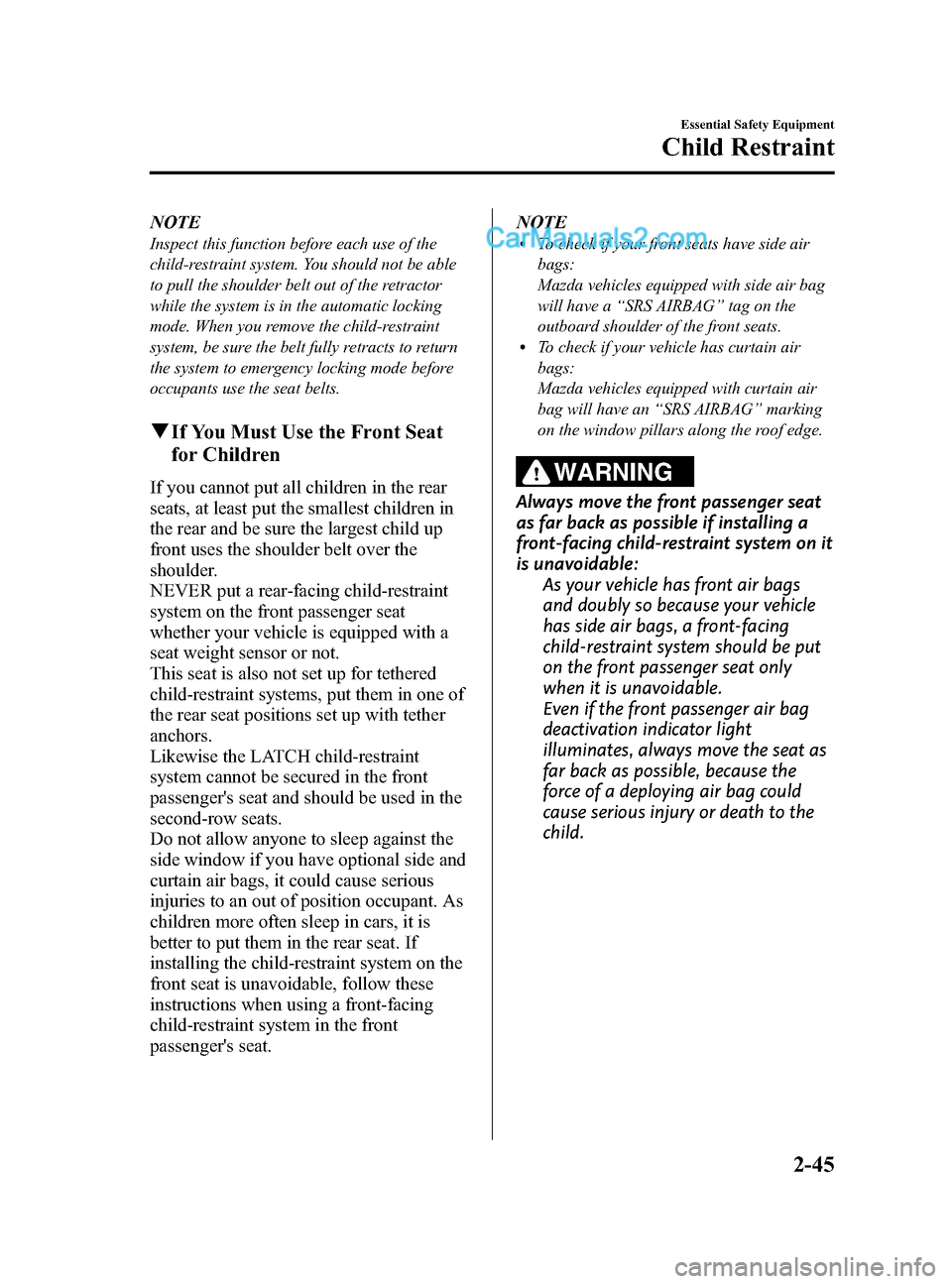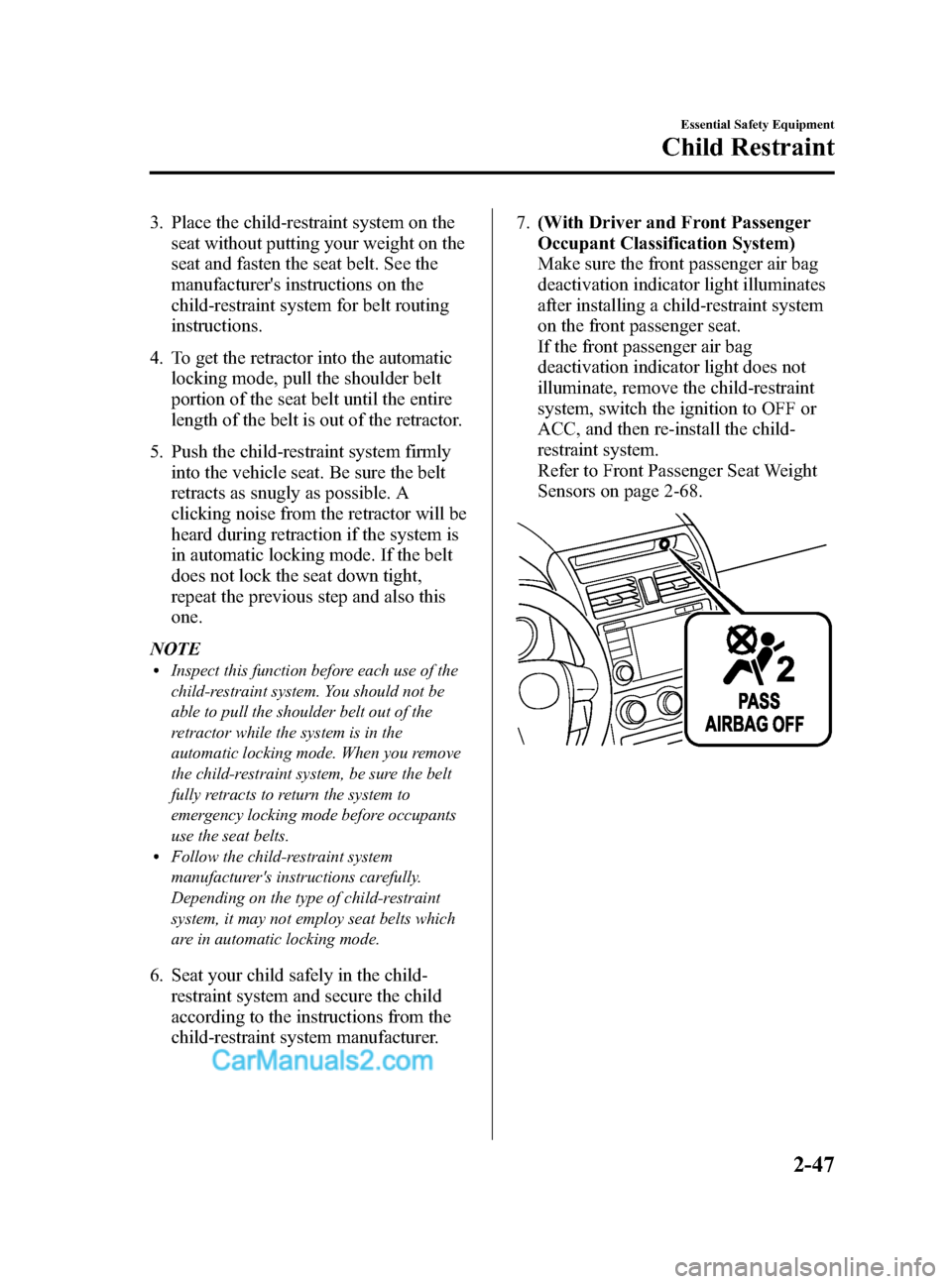ECU MAZDA MODEL CX-9 2014 (in English) User Guide
[x] Cancel search | Manufacturer: MAZDA, Model Year: 2014, Model line: MODEL CX-9, Model: MAZDA MODEL CX-9 2014Pages: 600
Page 48 of 600

Black plate (48,1)
WARNING
Use the correct size child-restraint system:For effective protection in vehicle accidents and sudden stops, a child must be
properly restrained using a seat belt or child-restraint system depending on age and
size. If not, the child could be seriously injured or even killed in an accident.
Follow the manufacturer's instructions and always keep the child-restraint system
buckled down: An unsecured child-restraint system is dangerous. In a sudden stop or a collision it
could move causing serious injury or death to the child or other occupants. Make
sure any child-restraint system is properly secured in place according to the child-
restraint system manufacturer's instructions. When not in use, remove it from the
vehicle or fasten it with a seat belt, or latch it down to BOTH LATCH lower anchors
for LATCH child-restraint systems and the corresponding tether anchor.
Always secure a child in a proper child-restraint system: Holding a child in your arms while the vehicle is moving is extremely dangerous. No
matter how strong the person may be, he or she cannot hold onto a child in a
sudden stop or collision and it could result in serious injury or death to the child or
other occupants. Even in a moderate accident, the child may be exposed to air bag
forces that could result in serious injury or death to the child, or the child may be
slammed into an adult, causing injury to both child and adult.
Never use a rear-facing child-restraint system in the front seat with an air bag that
could deploy: Rear-facing child-restraint systems on the front seat are particularly dangerous even
though you may feel assured that a front passenger air bag will not deploy based on
the fact that the front passenger air bag deactivation indicator light illuminates. The
child-restraint system can be hit by a deploying air bag and moved violently
backward resulting in serious injury or death to the child.
Do not use a rearward facing child restraint on a seat protected by an airbag in front
of it.
2-36
Essential Safety Equipment
Child Restraint
CX-9_8DA3-EA-13G_Edition2 Page48
Monday, September 9 2013 4:7 PM
Form No.8DA3-EA-13G
Page 51 of 600

Black plate (51,1)
Never use one seat belt on more than one person at a time:Using one seat belt for more than one person at a time is dangerous. A seat belt
used in this way cannot spread the impact forces properly and the two passengers
could be crushed together and seriously injured or even killed. Never use one belt for
more than one person at a time and always operate the vehicle with each occupant
properly restrained.
CAUTION
A seat belt or child-restraint system can become very hot in a closed vehicle during
warm weather. To avoid burning yourself or a child, check them before you or your
child touches them.
NOTE
Your Mazda is equipped with LATCH lower anchors for attachment of specially designed LATCH
child-restraint systems in the rear seats. When using these anchors to secure a child-restraint system,
refer to “LATCH Child-Restraint Systems ”(page 2-49).
Essential Safety Equipment
Child Restraint
2-39
CX-9_8DA3-EA-13G_Edition2 Page51
Monday, September 9 2013 4:7 PM
Form No.8DA3-EA-13G
Page 54 of 600

Black plate (54,1)
2. If the seat in which you install a child-restraint system has a seat slide
function, slide the seat as far back as
possible.
3. Make sure the seatback is securely latched by pushing it back until it is
fully locked.
4. Raise the head restraint to the top locked position.
Refer to Head Restraints on page 2-15.
5. Secure the child-restraint system with the lap portion of the lap/shoulder belt.
See the manufacturer's instructions on
the child-restraint system for belt
routing instructions.
6. To get the retractor into the automatic locking mode, pull the shoulder belt
portion of the seat belt until the entire
length of the belt is out of the retractor.7. Push the child-restraint system firmlyinto the vehicle seat. Be sure the belt
retracts as snugly as possible. A
clicking noise from the retractor will be
heard during retraction if the system is
in the automatic locking mode. If the
belt does not lock the seat down tight,
repeat this step.
NOTE
Inspect this function before each use of the
child-restraint system. You should not be able
to pull the shoulder belt out of the retractor
while the system is in the automatic locking
mode. When you remove the child-restraint
system, be sure the belt fully retracts to return
the system to emergency locking mode before
occupants use the seat belts.
8. If your child-restraint system requiresthe use of a tether strap, refer to the
manufacturer's instructions to hook and
tighten the tether strap after raising the
head restraint.
2-42
Essential Safety Equipment
Child Restraint
CX-9_8DA3-EA-13G_Edition2 Page54
Monday, September 9 2013 4:7 PM
Form No.8DA3-EA-13G
Page 55 of 600

Black plate (55,1)
Anchor bracket location
Tether strap position
Tether strap
Forward
WARNING
Use the tether and tether anchor only
for a child-restraint system:Using the tether or tether anchor to
secure anything but a child-restraint
system is dangerous. This could
weaken or damage the tether or
tether anchor and result in injury.
Always route the tether strap between
the head restraint and the seatback: Routing the tether strap on top of the
head restraint is dangerous. In a
collision the tether strap could slide
off the head restraint and loosen the
child-restraint system. The child-
restraint system could move which
may result in death or injury to the
child.
Always attach the tether strap to the
correct tether anchor position: Attaching the tether strap to the
incorrect tether anchor position is
dangerous. In a collision, the tether
strap could come off and loosen the
child-restraint system. If the child-
restraint system moves it could result
in death or injury to the child.
Essential Safety Equipment
Child Restraint
2-43
CX-9_8DA3-EA-13G_Edition2 Page55
Monday, September 9 2013 4:7 PM
Form No.8DA3-EA-13G
Page 56 of 600

Black plate (56,1)
qThird-Row Seats Child-Restraint
System Installation
The third-row seats cannot accommodate
LATCH-type child-restraint systems or
tethers, therefore these systems must be
installed on the other seat positions such
as the second-row seat. If this is not
possible, LATCH-type child-restraint
systems should be installed to a third-row
seat using the seat belt depending on
whether the child-restraint manufacturer
allows their use without LATCH
attachments and tether anchors.
Follow these manufacturer's instructions
when using a child-restraint system.
NOTE
lFollow the child-restraint system
manufacturer's instructions carefully.
Depending on the type of child-restraint
system, it may not employ seat belts which
are in automatic locking mode.
l(With foldable head restraints)
The third-row outboard head restraints
cannot be adjusted.
1. (Without foldable head restraints)
Raise the head restraint to the top
locked position. Refer to Head
Restraints on page 2-15.
2. Secure the child-restraint system with the lap portion of the lap/shoulder belt.
See the manufacturer's instructions on
the child-restraint system for belt
routing instructions. 3. To get the retractor into the automatic
locking mode, pull the shoulder belt
portion of the seat belt until the entire
length of the belt is out of the retractor.
4. Push the child-restraint system firmlyinto the vehicle seat. Be sure the belt
retracts as snugly as possible. Clicking
from the retractor will be heard during
retraction if the system is in the
automatic locking mode. If the belt
does not lock the seat down tight,
repeat this step.
2-44
Essential Safety Equipment
Child Restraint
CX-9_8DA3-EA-13G_Edition2 Page56
Monday, September 9 2013 4:7 PM
Form No.8DA3-EA-13G
Page 57 of 600

Black plate (57,1)
NOTE
Inspect this function before each use of the
child-restraint system. You should not be able
to pull the shoulder belt out of the retractor
while the system is in the automatic locking
mode. When you remove the child-restraint
system, be sure the belt fully retracts to return
the system to emergency locking mode before
occupants use the seat belts.
qIf You Must Use the Front Seat
for Children
If you cannot put all children in the rear
seats, at least put the smallest children in
the rear and be sure the largest child up
front uses the shoulder belt over the
shoulder.
NEVER put a rear-facing child-restraint
system on the front passenger seat
whether your vehicle is equipped with a
seat weight sensor or not.
This seat is also not set up for tethered
child-restraint systems, put them in one of
the rear seat positions set up with tether
anchors.
Likewise the LATCH child-restraint
system cannot be secured in the front
passenger's seat and should be used in the
second-row seats.
Do not allow anyone to sleep against the
side window if you have optional side and
curtain air bags, it could cause serious
injuries to an out of position occupant. As
children more often sleep in cars, it is
better to put them in the rear seat. If
installing the child-restraint system on the
front seat is unavoidable, follow these
instructions when using a front-facing
child-restraint system in the front
passenger's seat. NOTE
lTo check if your front seats have side air
bags:
Mazda vehicles equipped with side air bag
will have a
“SRS AIRBAG ”tag on the
outboard shoulder of the front seats.
lTo check if your vehicle has curtain air
bags:
Mazda vehicles equipped with curtain air
bag will have an “SRS AIRBAG ”marking
on the window pillars along the roof edge.
WARNING
Always move the front passenger seat
as far back as possible if installing a
front-facing child-restraint system on it
is unavoidable: As your vehicle has front air bags
and doubly so because your vehicle
has side air bags, a front-facing
child-restraint system should be put
on the front passenger seat only
when it is unavoidable.
Even if the front passenger air bag
deactivation indicator light
illuminates, always move the seat as
far back as possible, because the
force of a deploying air bag could
cause serious injury or death to the
child.
Essential Safety Equipment
Child Restraint
2-45
CX-9_8DA3-EA-13G_Edition2 Page57
Monday, September 9 2013 4:7 PM
Form No.8DA3-EA-13G
Page 59 of 600

Black plate (59,1)
3. Place the child-restraint system on theseat without putting your weight on the
seat and fasten the seat belt. See the
manufacturer's instructions on the
child-restraint system for belt routing
instructions.
4. To get the retractor into the automatic locking mode, pull the shoulder belt
portion of the seat belt until the entire
length of the belt is out of the retractor.
5. Push the child-restraint system firmly into the vehicle seat. Be sure the belt
retracts as snugly as possible. A
clicking noise from the retractor will be
heard during retraction if the system is
in automatic locking mode. If the belt
does not lock the seat down tight,
repeat the previous step and also this
one.
NOTE
lInspect this function before each use of the
child-restraint system. You should not be
able to pull the shoulder belt out of the
retractor while the system is in the
automatic locking mode. When you remove
the child-restraint system, be sure the belt
fully retracts to return the system to
emergency locking mode before occupants
use the seat belts.
lFollow the child-restraint system
manufacturer's instructions carefully.
Depending on the type of child-restraint
system, it may not employ seat belts which
are in automatic locking mode.
6. Seat your child safely in the child- restraint system and secure the child
according to the instructions from the
child-restraint system manufacturer. 7.
(With Driver and Front Passenger
Occupant Classification System)
Make sure the front passenger air bag
deactivation indicator light illuminates
after installing a child-restraint system
on the front passenger seat.
If the front passenger air bag
deactivation indicator light does not
illuminate, remove the child-restraint
system, switch the ignition to OFF or
ACC, and then re-install the child-
restraint system.
Refer to Front Passenger Seat Weight
Sensors on page 2-68.
Essential Safety Equipment
Child Restraint
2-47
CX-9_8DA3-EA-13G_Edition2 Page59
Monday, September 9 2013 4:7 PM
Form No.8DA3-EA-13G
Page 61 of 600

Black plate (61,1)
LATCH Child-Restraint Systems
Your Mazda is equipped with LATCH lower anchors for attachment of specially designed
LATCH child-restraint systems in the second-row seats. Both anchors must be used,
otherwise the seat will bounce around and put the child in danger. Most LATCH child-
restraint systems must also be used in conjunction with a tether to be effective. If they have
a tether you must use it to better assure your child's safety.
WARNING
Follow the manufacturer's instructions for the use of the child-restraint system:An unsecured child-restraint system is dangerous. In a sudden stop or a collision it
could move causing serious injury or death to the child or other occupants. Make
sure the child-restraint system is properly secured in place according to the child-
restraint system manufacturer's instructions.
Never attach two child-restraint systems to the same LATCH lower anchor: Attaching two child-restraint systems to the same LATCH lower anchor is dangerous.
In a collision, one anchor may not be strong enough to hold two child-restraint
system attachments, and it may break, causing serious injury or death. If you use the
seat position for another child-restraint system when an outboard LATCH position is
occupied, use the center seat belts instead, and the tether if tether-equipped.
Make sure the child-restraint system is properly secured: An unsecured child-restraint system is dangerous. In a sudden stop or a collision it
could move causing serious injury or death to the child or other occupants. Follow
the child-restraint system manufacturer's instructions on belt routing to secure the
seat just as you would with a child in it so that nobody is tempted to put a child in
an improperly secured seat later on. When not in use, remove it from the vehicle or
fasten it with a seat belt, or latch it down to BOTH LATCH lower anchors for LATCH
child-restraint systems.
Make sure there are no seat belts or foreign objects near or around the LATCH child-
restraint system: Not following the child-restraint system manufacturer's instructions when installing
the child-restraint system is dangerous. If seat belts or a foreign object prevent the
child-restraint system from being securely attached to the LATCH lower anchors and
the child-restraint system is installed improperly, the child-restraint system could
move in a sudden stop or collision causing serious injury or death to the child or
other occupants. When installing the child-restraint system, make sure there are no
seat belts or foreign objects near or around the LATCH lower anchors. Always follow
the child-restraint system manufacturer's instructions.
Essential Safety Equipment
Child Restraint
2-49
CX-9_8DA3-EA-13G_Edition2 Page61
Monday, September 9 2013 4:7 PM
Form No.8DA3-EA-13G
Page 62 of 600

Black plate (62,1)
qLATCH Child-Restraint System
Installation Procedure (Second-
Row Outboard Seats)
1. Slide the second-row seat as far back as
possible.
2. Make sure the seatback is securely latched by pushing it back until it is
fully locked.
3. Expand the area between the seat bottom and the seatback slightly to
verify the locations of the LATCH
lower anchors.
For rear
right seat For rear
left seat
NOTE
The markings above the LATCH lower anchors
indicate the locations of LATCH lower
anchors for the attachment of a child-restraint
system.
4. Raise the head restraint to the top
locked position.
Refer to Head Restraints on page 2-15.
5. Secure the child-restraint system using BOTH LATCH lower anchors,
following the child-restraint system
manufacturer's instruction. Pull on the
child-restraint to be sure both anchors
are engaged. 6. If your child-restraint system came
equipped with a tether, that means it is
very important to properly secure the
tether for child safety. Please carefully
follow the child-restraint system
manufacturer's instructions when
installing tethers.
Anchor bracket location
Tether strap position
Tether strap
Forward
2-50
Essential Safety Equipment
Child Restraint
CX-9_8DA3-EA-13G_Edition2 Page62
Monday, September 9 2013 4:7 PM
Form No.8DA3-EA-13G
Page 63 of 600

Black plate (63,1)
WARNING
Use the tether and tether anchor only
for a child-restraint system:Using the tether or tether anchor to
secure anything but a child-restraint
system is dangerous. This could
weaken or damage the tether or
tether anchor and result in injury.
Always route the tether strap between
the head restraint and the seatback: Routing the tether strap on top of the
head restraint is dangerous. In a
collision the tether strap could slide
off the head restraint and loosen the
child-restraint system. The child-
restraint system could move which
may result in death or injury to the
child.
Always attach the tether strap to the
correct tether anchor position: Attaching the tether strap to the
incorrect tether anchor position is
dangerous. In a collision, the tether
strap could come off and loosen the
child-restraint system. If the child-
restraint system moves it could result
in death or injury to the child.
qLATCH Child-Restraint System
Installation Procedure (Second-
Row Center Seat)
The LATCH lower anchors at the center
of the second-row seat are much further
apart than the sets of LATCH lower
anchors for child-restraint system
installation at other seating positions.
Child-restraint systems with rigid LATCH
attachments cannot be installed on the
center seating position. Some LATCH
equipped child-restraint systems can be
placed in the center position and will
reach the nearest LATCH lower anchors
which are 500 mm (19.7 in) apart.
LATCH compatible child-restraint
systems (with attachments on belt
webbing) can be used at this seating
position only if the child-restraint system
manufacturer's instructions state that the
child-restraint system can be installed to
LATCH lower anchors that are 500 mm
(19.7 in) apart. Do not attach two child-
restraint systems to the same LATCH
lower anchor. If your child-restraint
system has a tether, it must also be used
for your child's optimum safety.
Essential Safety Equipment
Child Restraint
2-51
CX-9_8DA3-EA-13G_Edition2 Page63
Monday, September 9 2013 4:7 PM
Form No.8DA3-EA-13G